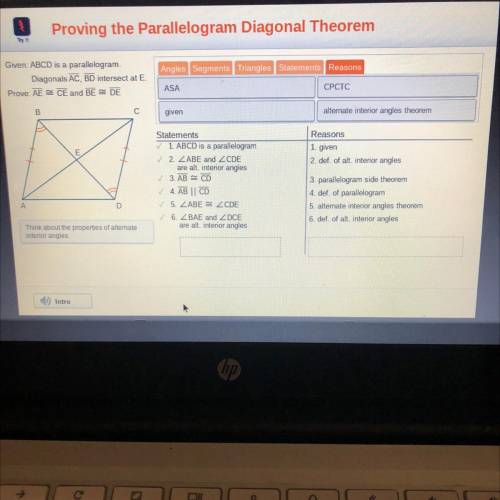Proving the Parallelogram Diagonal Theorem
Try it
Angles Segments Triangles Statements Reason...

Mathematics, 22.02.2021 04:50 willisanthony7815
Proving the Parallelogram Diagonal Theorem
Try it
Angles Segments Triangles Statements Reasons
SIRE
Given: ABCD is a parallelogram.
Diagonals AC, BD intersect at E.
Prove: AE CE and BE DE
ASA
CPCTC
VX
B
с
given
alternate interior angles theorem
E
Reasons
1. given
2. def. of alt, interior angles
Statements
✓ 1. ABCD is a parallelogram
✓ 2. ZABE and ZCDE
are alt. interior angles
✓ 3. AB CD
✓ 4. AB || CD
✓ 5. ZABEZCDE
✓ 6. Z BAE and ZDCE
are alt. interior angles
3. parallelogram side theorem
4. def. of parallelogram
5. alternate interior angles theorem
6. def. of alt, interior angles
A
D
Think about the properties of alternate
interior angles


Answers: 3


Other questions on the subject: Mathematics

Mathematics, 21.06.2019 16:50, fireman59937
Kapil needed to buy a long wooden beam. he went to two sawmills that each charge an initial fee plus an additional fee for each meter of wood. the following equation gives the price (in dollars) of a wooden beam from the first sawmill as a function of its length (in meters). p = 5+20xp=5+20x
Answers: 1


Mathematics, 21.06.2019 19:30, jrassicworld4ever
Need now max recorded the heights of 500 male humans. he found that the heights were normally distributed around a mean of 177 centimeters. which statements about max’s data must be true? a) the median of max’s data is 250 b) more than half of the data points max recorded were 177 centimeters. c) a data point chosen at random is as likely to be above the mean as it is to be below the mean. d) every height within three standard deviations of the mean is equally likely to be chosen if a data point is selected at random.
Answers: 1

Mathematics, 21.06.2019 21:10, verdolaga2017me
What is the domain of the given function? {(3,-2), (6, 1), (-1, 4), (5,9), (-4, 0); o {x | x= -4,-1, 3, 5, 6} o {yl y = -2,0, 1,4,9} o {x|x = -4,-2, -1,0, 1, 3, 4, 5, 6, 9} o y y = 4,-2, -1, 0, 1, 3, 4, 5, 6, 9}
Answers: 1
You know the right answer?
Questions in other subjects:


Mathematics, 15.12.2020 22:20


Mathematics, 15.12.2020 22:20

History, 15.12.2020 22:20

Mathematics, 15.12.2020 22:20


Mathematics, 15.12.2020 22:20




